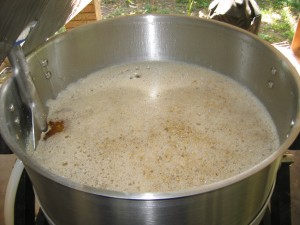This is the fifth installment in the All-Grain Brew Day Walkthough, which started with a post on strike water preparation.
When the mash is over, there is a sudden flurry of activity by the brewer. The brewer should mash out by heating the mash directly, or infusing it with boiling water, to raise the temperature to 170 °F (77 °C). If a brewer has mashed in his or her kettle, he or she may heat the mash to a couple degrees above this, then scoop the contents over to their lauter tun (where it will hopefully settle in around 170 °F (77 °C). In addition, if the brewer expects — based on past experience — that the grain bed temperature will decrease during recirculation, he may heat the mash to a few degrees over 170 °F (77 °C). With the relatively low pH of an undiluted mash, excess tannin extraction is not a problem, even when the grain bed exceeds 170 °F (77 °C).



Recent Comments